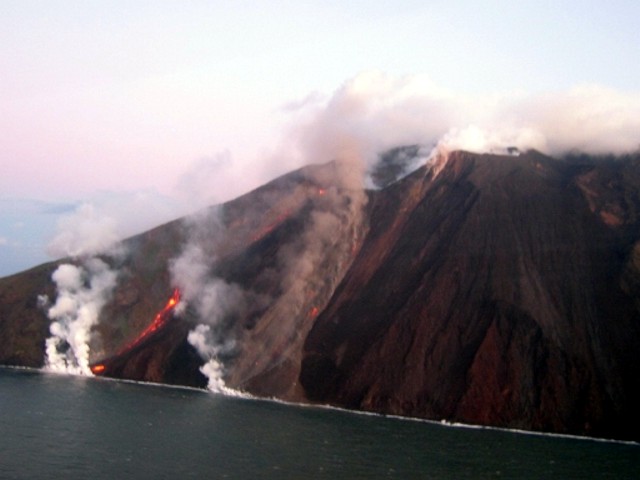Report on Stromboli (Italy) — April 2007
Bulletin of the Global Volcanism Network, vol. 32, no. 4 (April 2007)
Managing Editor: Richard Wunderman.
Stromboli (Italy) Flank eruption begins on 27 February 2007
Please cite this report as:
Global Volcanism Program, 2007. Report on Stromboli (Italy) (Wunderman, R., ed.). Bulletin of the Global Volcanism Network, 32:4. Smithsonian Institution. https://doi.org/10.5479/si.GVP.BGVN200704-211040
Stromboli
Italy
38.789°N, 15.213°E; summit elev. 924 m
All times are local (unless otherwise noted)
According to Sonia Calvari of Istituto Nazionale di Geofisica e Vulcanologia (INGV-CT), a flank eruption started on Stromboli volcano on 27 February 2007 and continued to at least 15 March. Compared to the previous flank eruption during 2002-2003, lava effusion was about an order of magnitude greater. Initially, a NE fissure opened on the NE flank of the NE-crater, and lava emitted from the fissure formed three branches and rapidly reached the sea (figure 75).
 |
Figure 75. Lava from Stromboli reaching the sea on 27 February 2007. Courtesy of the INGV-CT 2007 Stromboli eruption web site. |
Late on the eruption's first day, the three initial flows stopped and a new vent opened at the E Margin of the Sciara del Fuoco at about 400 m elevation. In a few days, this vent emitted sufficient lava to build a lava bench several tens of meters wide, which significantly modified the coastline. These lava emissions stopped for a few hours on 9 March, after which another vent opened at about 550 m elevation on the N flank of the NE-crater, almost in the same position as one of the vents of the 2002-2003 eruption. The 550-m vent was active for less than 24 hours and, when it ceased emitting lava, the 400-m vent reopened, again feeding lava to the sea.
On 15 March 2007, while the effusion from the 400-m vent continued, a major explosion occurred at 2137 (2037 UTC). This event, similar to that on 5 April 2003 (BGVN 28:04), was recorded by all the INGV-CT monitoring web cams. As in 2003, the 2007 event occurred during a flank effusive eruption, when the summit craters were obstructed by debris fallen from the crater rims. Still images and videos can be downloaded from the INGV-CT webpage dedicated to the 2007 Stromboli eruption.
Satellite imagery. Satellite imagery revealed an ash plume fanning SSE from the eruption site beginning at 1215 UTC on 27 February 2007. Another eruption was observed on MET-8 split-window IR (infrared) imagery on the same day at 1830 UTC. Ash then blew SSE at 46-56 km/hour.
Geological Summary. Spectacular incandescent nighttime explosions at Stromboli have long attracted visitors to the "Lighthouse of the Mediterranean" in the NE Aeolian Islands. This volcano has lent its name to the frequent mild explosive activity that has characterized its eruptions throughout much of historical time. The small island is the emergent summit of a volcano that grew in two main eruptive cycles, the last of which formed the western portion of the island. The Neostromboli eruptive period took place between about 13,000 and 5,000 years ago. The active summit vents are located at the head of the Sciara del Fuoco, a prominent scarp that formed about 5,000 years ago due to a series of slope failures which extends to below sea level. The modern volcano has been constructed within this scarp, which funnels pyroclastic ejecta and lava flows to the NW. Essentially continuous mild Strombolian explosions, sometimes accompanied by lava flows, have been recorded for more than a millennium.
Information Contacts: Sonia Calvari, Istituto Nazionale di Geofisica e Vulcanologia Sezione di Catania, Piazza Roma 2, 95123 Catania, Italy (URL: http://www.ct.ingv.it/); INGV-CT 2007 Stromboli eruption website (URL: http://www.ct.ingv.it/stromboli2007/main.htm); U.S. Air Force Weather Agency (AFWA)/XOGM, Offutt Air Force Base, NE 68113, USA.

